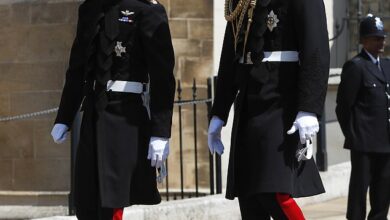How Queen Victoria (born 205 years ago today) became the monarch after three uncles died without heirs – but her 63-year reign defined an age
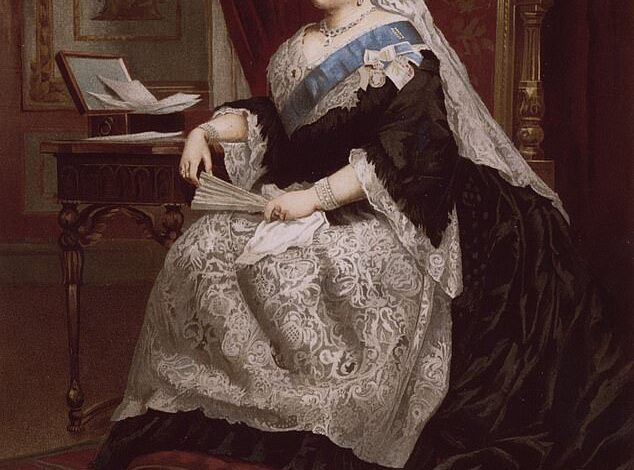
She was a princess born amidst a succession crisis – after her father won the race to produce a legitimate heir.
Although she was a seemingly safe fifth in line to the throne when she arrived into the world 205 years ago today, fate had other ideas – just like it did with her great-great-granddaughter Queen Elizabeth II.
Queen Victoria – as she became aged 18 in 1837 after her three uncles died without surviving heirs – went on to rule for 63 years, seven months and two days.
Her reign defined an era of staid morality and epic industrial and social change.
By the time Victoria died aged 81 in 1901, she was known as ‘the Grandmother of Europe’.
Germany‘s Kaiser Wilhelm and Russia‘s Empress Alexandra were among her many grandchildren.
Her reign was only eclipsed by Queen Elizabeth, who was on the throne for more than 70 years but who only ever became monarch because her uncle Edward VIII abdicated.
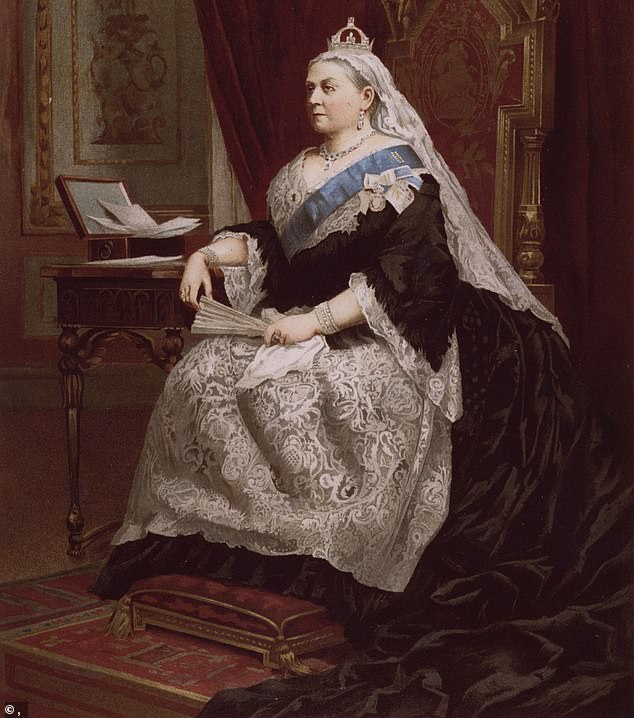
Queen Victoria – as she became aged 18 in 1837 after her three uncles died without surviving heirs – ruled for 63 years, seven months and two days
Birth
Victoria was born after her uncle George IV’s only daughter Princess Charlotte had died giving birth to a stillborn son.
The 21-year-old was in labour for an agonising 50 hours after which she haemorrhaged and died.
In a desperate ‘baby race’, the King’s unmarried brothers attempted to produce legitimate heirs to the throne.
Victoria’s father, Prince Edward Augustus, hastily married German widow Marie Luise Victoire, Dowager Duchess of Leiningen.
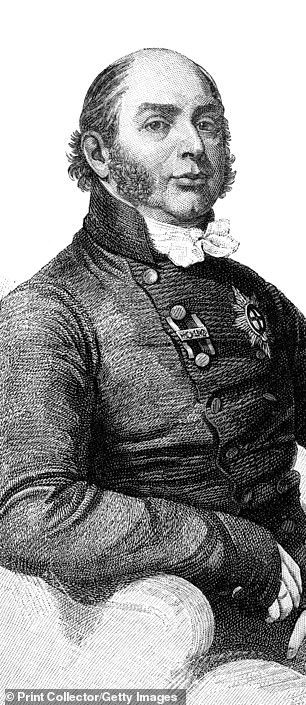
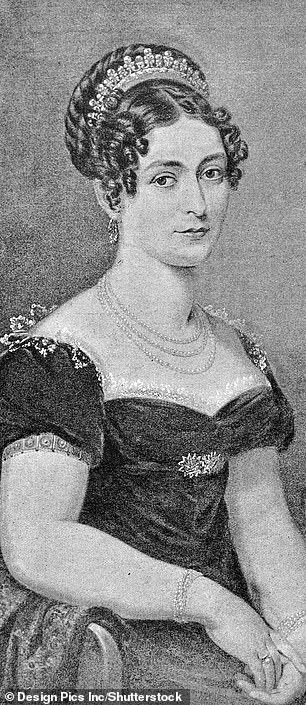
Victoria was born to her parents Prince Edward Augustus (left) and Marie Luise Victoire, Dowager Duchess of Leiningen (right)
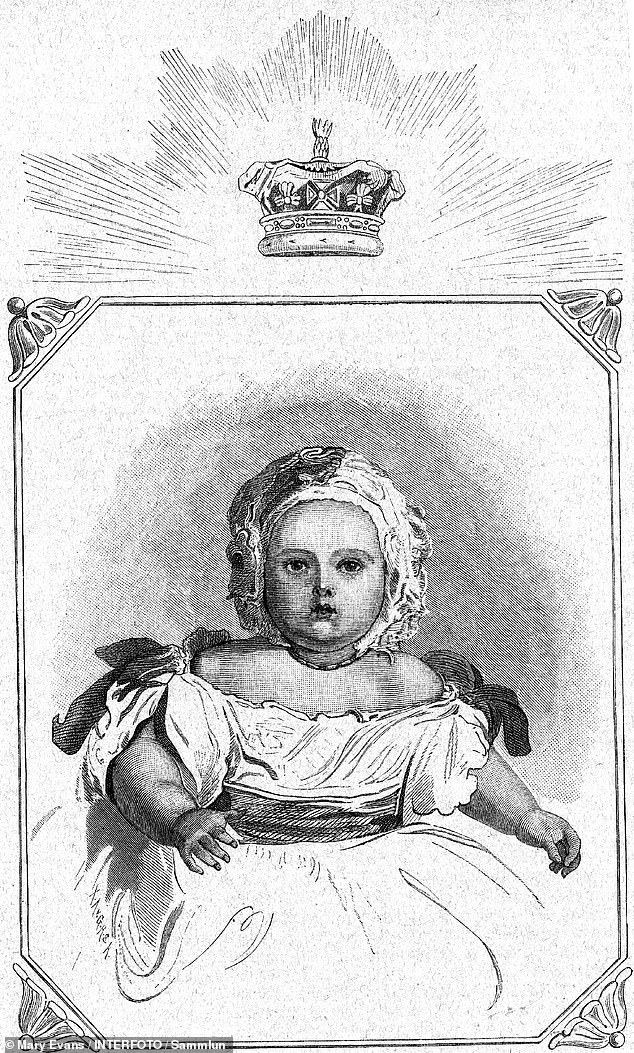
Victoria was born on May 24, 1819 in the dining room at Kensington Palace
The pair rushed back to England, where Victoria was born in the dining room of Kensington Palace – so that hot water could be brought up quickly from the kitchens to her pained mother.
The baby was described as ‘plump as a partridge’ and christened Alexandrina Victoria.
Childhood
According to Victoria, she was ‘brought up very simply’.
After her father died when she was just eight months old, his personal equerry Sir John Conroy seized the opportunity to act as ‘advisor’ to her mother, whose English was poor.
Conroy saw it as an opportunity to grow his influence in the royal household, implementing a strict set of rules for Victoria and her mother which he termed the Kensington System.
The system saw Victoria grow up in isolation from her father’s family – often turning to her beloved governess, Baronness Lehzen, and her little dog Dash for company.
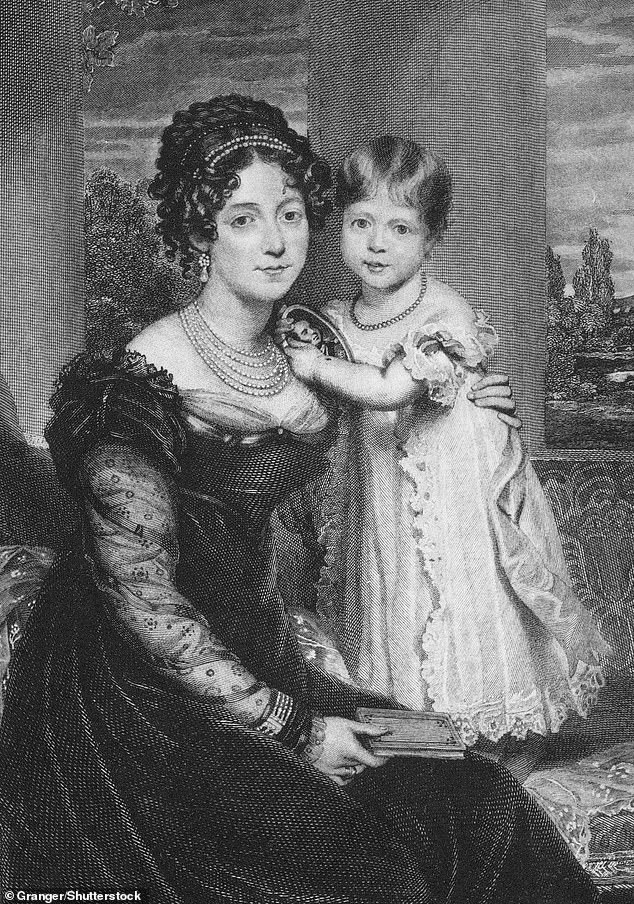
Princess Victoria with her mother, the Duchess of Kent. She was ‘brought up very simply’
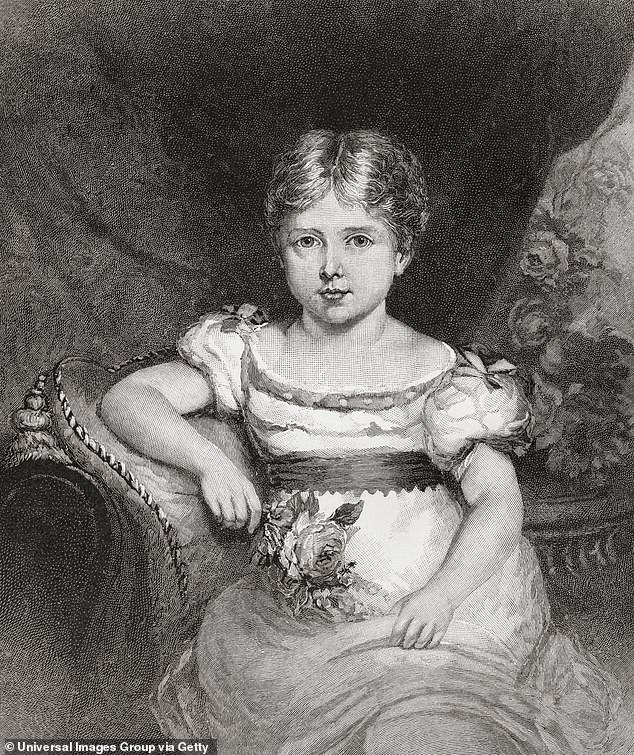
A portrait of Princess Victoria aged six. The little girl was raised in the confines of Kensington Palace
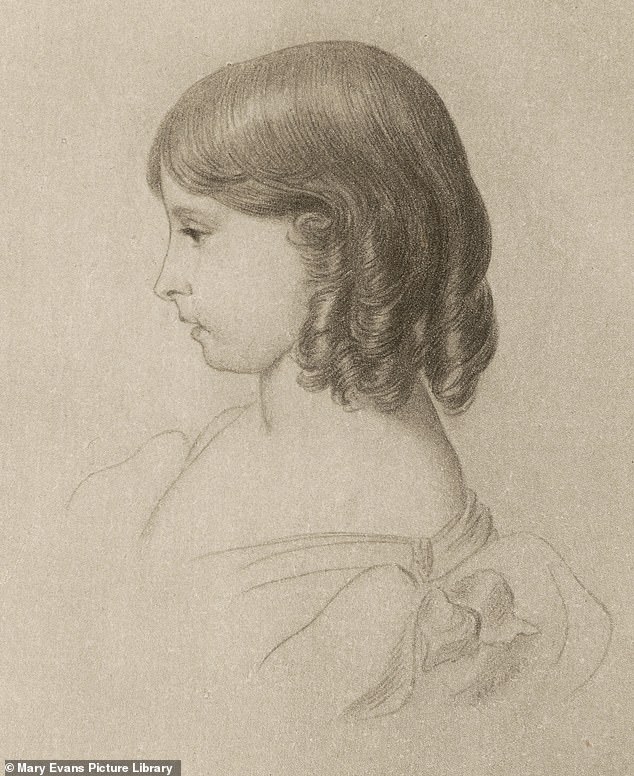
Victoria, pictured aged 10, first learned about her future role as monarch during a history lesson
Victoria first learned about her future role as monarch during a history lesson when she was only ten years old.
Her governess recalled her reacting to the discovery by saying: ‘I will be good’.
As a result of the Kensington System, the public did not associate the young princess with her unpopular uncles George IV and William IV.
When King William finally appeared to be on death’s door, her supporters were delighted by the prospect that she would ascend to the throne, presenting her as ‘The Nation’s Hope’.
Becoming Queen
At 6am on June 20, 1837, Victoria was woken to be told her uncle, the King, had died.
She wrote in her diary: ‘I got out of bed and went into my sitting-room (only in my dressing-gown), and alone, and saw them.
‘Lord Conyngham (the Lord Chamberlain) then acquainted me that my poor Uncle, the King, was no more, and had expired at 12 minutes p.2 this morning, and consequently that I am Queen.’
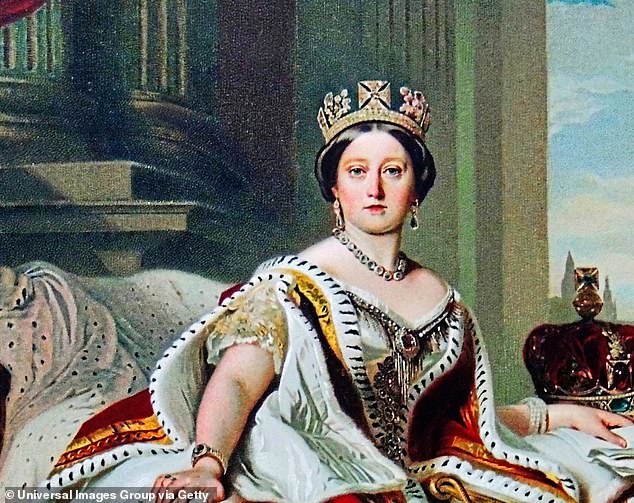
Queen Victoria was crowned on June 28, 1838. Above: The monarch in her coronation robes
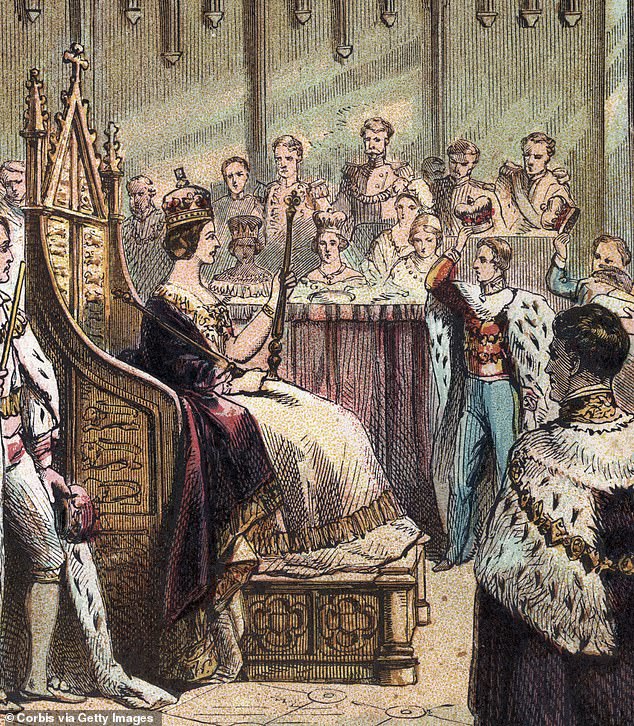
The young woman’s first action as queen was to exile her mother to a distant set of apartments as Victoria had never had a room to herself before. Above: A depiction of Victoria’s Coronation
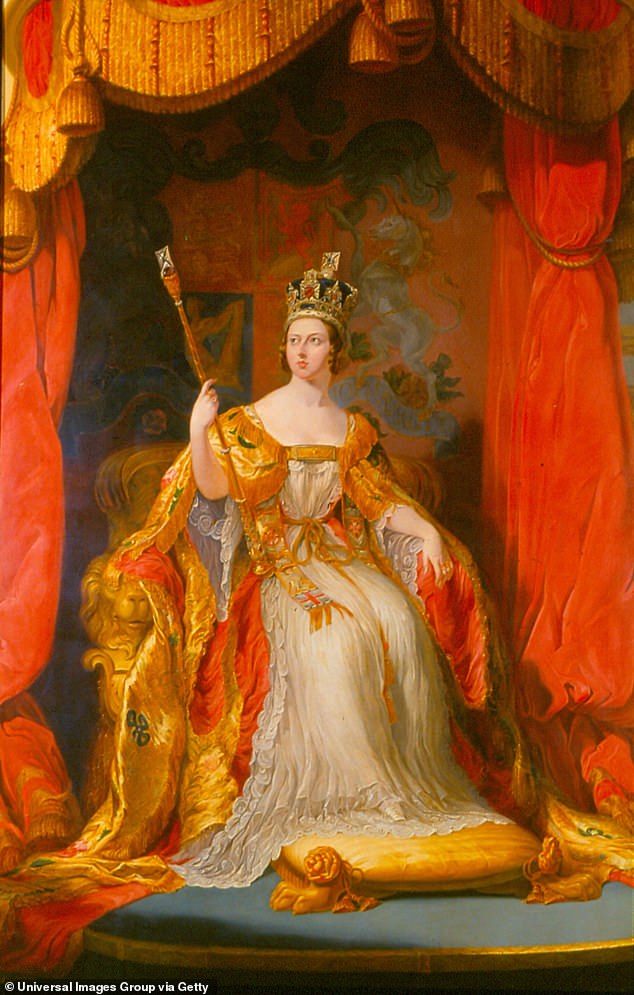
‘I shall do my utmost to do fulfil my duty towards my country,’ Victoria wrote in her diaries. Above: In her coronation robes
It is estimated that Victoria wrote more than 60million words, mainly in her diaries, throughout her life.
The young woman’s first action as queen was to exile her mother to a distant set of apartments as Victoria had never had a room to herself before.
She dismissed Conroy in order to throw off the shackles of his Kensington System and moved to Buckingham Palace almost immediately, only accompanied by Baroness Lehzen, her companion and former governess.
Victoria was crowned in Westminster Abbey on June 28, 1838.
‘I shall do my utmost to do fulfil my duty towards my country,’ she wrote in her diaries.
‘I am very young and perhaps in many, although not all, inexperienced, but I am sure that very few have more real good will and more real desire to do what is fit and right than I have.’
Prince Albert
Victoria first met her German cousin Prince Albert in 1836, when he and his brother Ernest visited Kensington Palace with their uncle Leopold, King of the Belgians.
Their families had arranged their union since the pair were very young, and when the couple met again in 1839, Victoria now the Queen, decided she was ready to marry the prince.
As protocol demanded, Victoria proposed to Albert on October 15, 1839 – just five days after he arrived at Windsor on a visit to the British court.
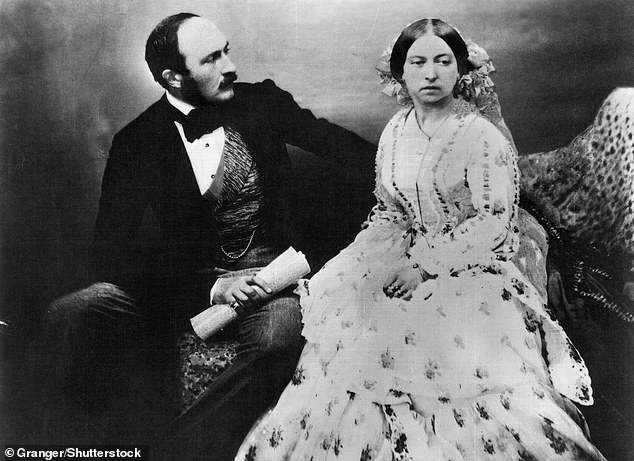
Queen Victoria photographed with Prince Albert in 1854. The couple were deeply in love and had nine children together
The marriage would help Victoria with her royal duties and improve her public standing, but the union had a deep bond underlying it.
The Queen wrote in her diary: ‘Oh how I adore and love him, I cannot say!’
Their wedding in February 1840 was the first royal union to take place with the enjoyment of the public in mind.
Victoria travelled to St James’s Palace in an open carriage so the crowds could admire her.
She wore a simple white satin dress with an orange blossom wreath in her hair.
Her uncle, the Duke of Sussex, walked her down the aisle in place of her late father.
The newly weds embarked on a short honeymoon which Victoria raved about her in diary, writing: ‘My dearest Albert put on my stockings for me. I went in and saw him shave; a great delight for me’.
Children
Victoria wrote that she found pregnancy difficult and was uncomfortable in the presence of children but, like many women at the time, a large family was her ambition.
Their first child, Victoria, was born in 1840. The Princess Royal was followed by Albert Edward (1841), Alice (1843), Alfred (1844), Helena (1846), Louise (1848), Arthur (1850), Leopold (1853) and Beatrice (1857).
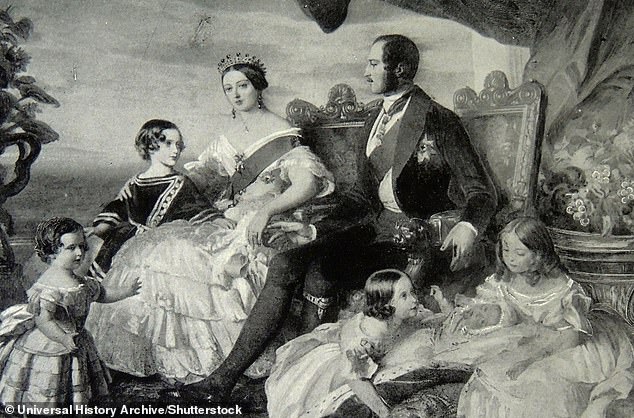
Queen Victoria and Prince Albert with five of their nine children, 1846
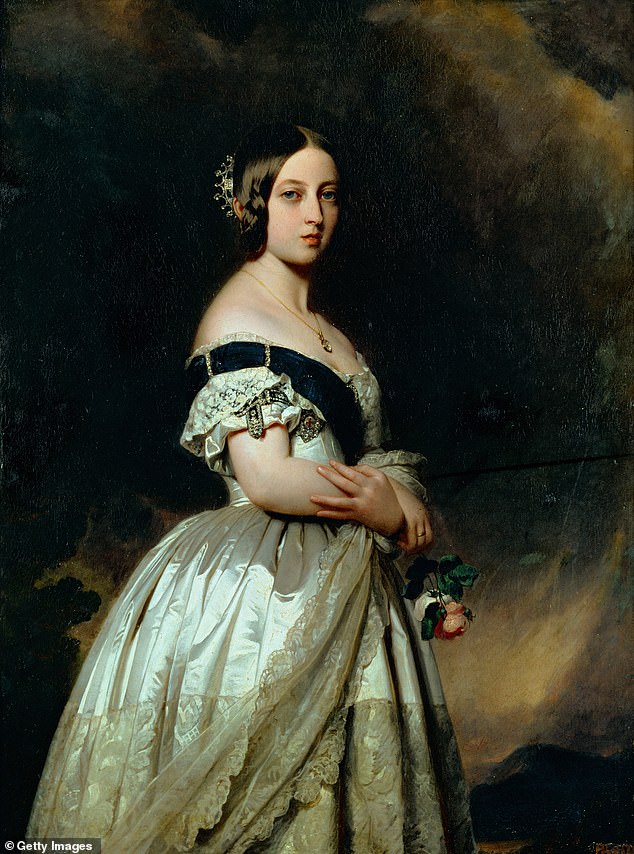
Victoria never lost her early passion for Albert, writing: ‘Without him everything loses its interest’
Victoria had marble sculptures made of each of her nine children – produced from casts taken of them while they were asleep.
The Queen’s first grandchild was born in 1859 and her first great-grandchild in 1879. There were 37 great-grandchildren alive at her death.
Despite conflicts produced by the Queen’s fierce temper and recurrent fits of depression, which usually occurred during and after pregnancy, the couple had a happy marriage.
Victoria never lost her early passion for Albert, writing: ‘Without him everything loses its interest.’
Albert carved out a powerful role as Prince Consort, taking charge of many of his wife’s commitments.
When she was pregnant, Albert had the honour of reading the daily government dispatches to her.
They even placed their desks side by side at Buckingham Palace so they would work together.
Against a backdrop of a world marked by huge advances in technology and legendary feats of construction, Prince Albert was fascinated with trade, industry, art and science.
In 1851 he organised the massively successful Great Exhibition.
With over 100,000 exhibits from all over the world, including the Koh-i-Nûr diamond, the exhibition attracted more than six million visitors.
Victoria was so fascinated by her husband’s achievements that she bought a ticket and attended the exhibition nearly every day for three months.
The death of her husband
Sadly for Victoria, the man she relied on for support died in 1861, aged only 42.
Queen Victoria was devastated. At a Privy Council meeting three weeks after his death she could not utter a word.
She wrote to her uncle Leopold: ‘The poor fatherless baby of eight months is now the utterly broken-hearted and crushed widow of forty-two! My life as a happy one is ended! The world is gone for me!’
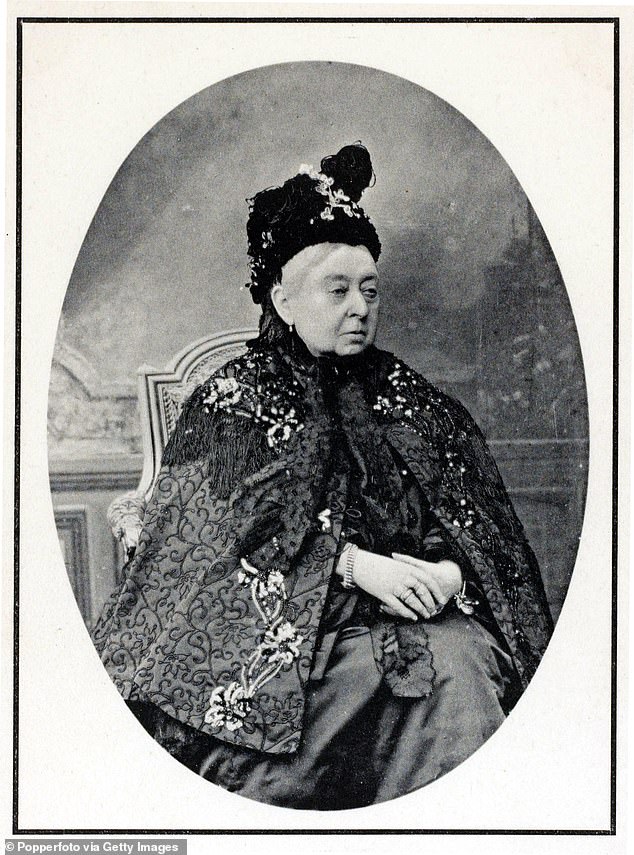
After Albert’s death in 1861, Victoria wore black for the rest of her life and her sharp withdrawal from public life lasted ten years
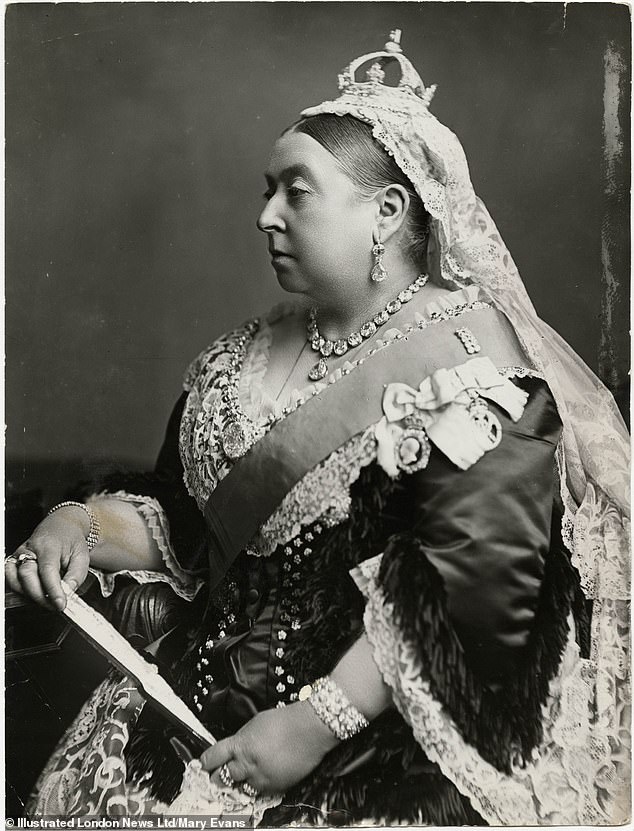
At a Privy Council meeting three weeks after Albert’s death, Queen Victoria could not utter a word
Victoria wore black for the rest of her life and her sharp withdrawal from public life lasted ten years.
The monarch almost obsessively tried to keep the presence of Albert in the lives of her nine children.
At one of her son’s weddings, she insisted the siblings pose around a bust of Albert.
Empire
During her reign, the British Empire underwent an enormous expansion.
Victoria had a had a personal servant from India, Abdul Karim, who taught the monarch how to speak Urdu.
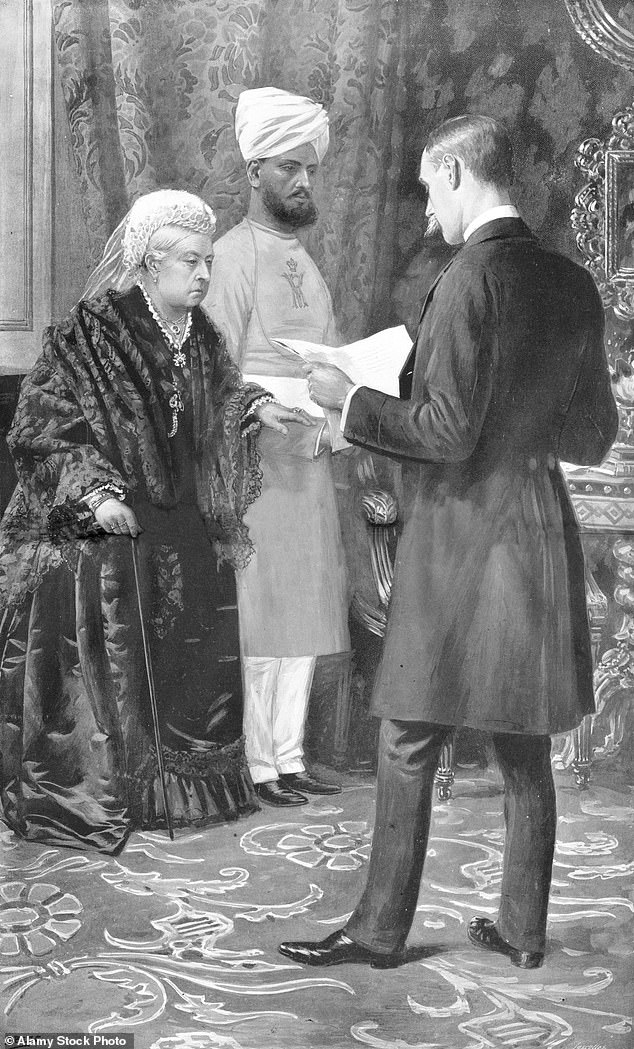
Queen Victoria, Empress of India, listening to a despatch alongside Abdul Karim, her Indian servant
By the end of her life, the Empire covered more than one-fifth of the world’s surface, including the entirety of the Indian sub-continent.
Victoria was crowned Empress of India on May 1, 1876.
Despite her title, Victoria never visited the country.
Golden and Diamond Jubilees
The Queen’s Golden Jubilee celebrations in 1887 and the even more extravagant Diamond Jubilee in 1897 helped to restore Victoria’s public image following the death of Prince Albert and her retreat behind the walls of Windsor Castle.
In a telegraph message to her subjects in 1897, Victoria wrote: ‘From my heart I thank my beloved people. May God bless them!’
Death
Victoria grew frail in later years and had to use a wheelchair.
Her surviving dresses from this time show adaptations to accommodate an osteoarthritic hump on her upper back.
Despite significant sight loss, Victoria continued to write in her diaries. The last entry was dated January 13, 1901.
She wrote: ‘Had a fair night, but was a little wakeful. Got up earlier & had some milk.’
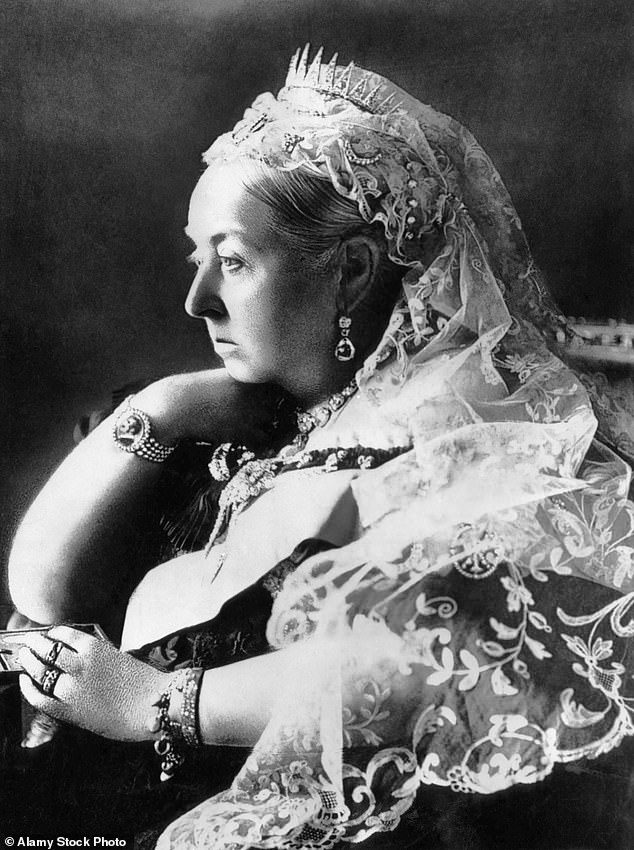
Victoria grew frail in later years and had to use a wheelchair. Above: The monarch in 1890
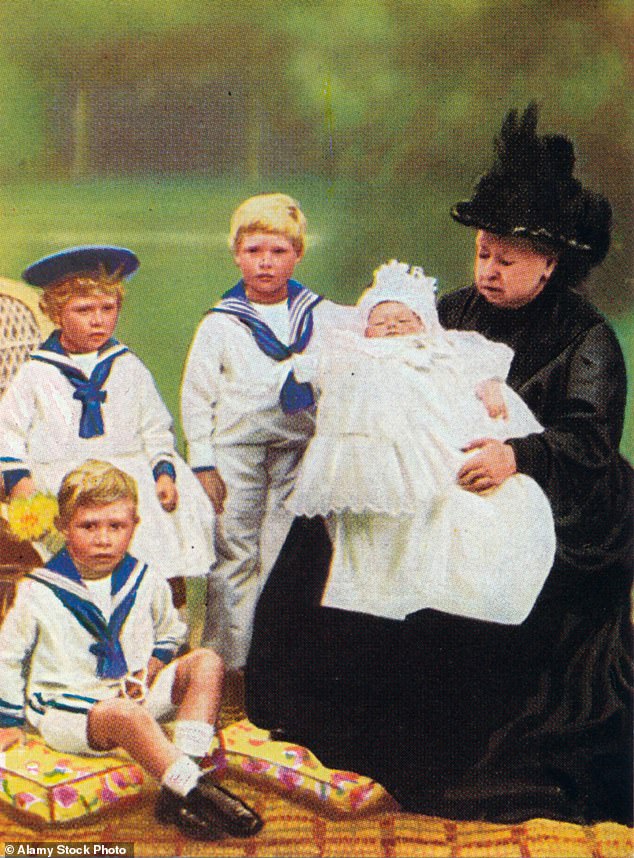
Queen Victoria pictured in 1900 with some of her great-grandchildren at Osbourne House, where she later died
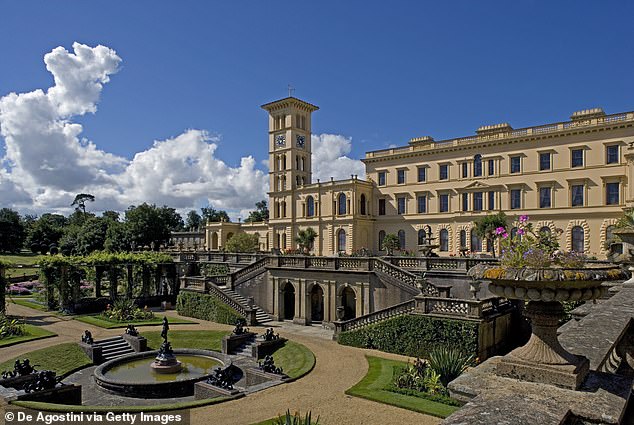
Osbourne House on the Isle of Wight was Queen Victoria’s summer residence
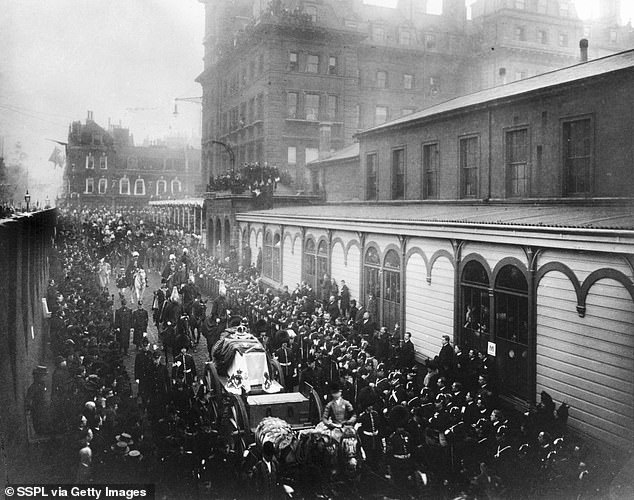
Queen Victoria’s funeral took place on February 4, 1901. Crowds lined the streets as her coffin was taken to St George’s Chapel in Windsor
Her first grandson, Kaiser Wilhelm II, rushed from Germany to be by Victoria’s side when she died on January 22 at Osborne House on the Isle of Wight.
Queen Victoria’s funeral took place on February 4, 1901.
In accordance with her wishes, she was dressed in white and wore her wedding veil.
Her coffin was taken first by boat to Hampshire before being carried by train to Victoria station.
Crowds in London lined the streets as they sought to get a final glimpse of the Queen.
Her coffin was then taken to Windsor’s St George’s Chapel. The Queen had requested that casts of her children’s hands and Albert’s dressing gown be placed in her coffin.
After the funeral service, she was laid to rest inside Frogmore Mausoleum, which Victoria had built for Albert after his death.
Above its mausoleum’s doors, Victoria’s choice words read: ‘Vale desideratissime. Farewell most beloved. Here at length, I shall rest with thee, with thee in Christ I shall rise again.’



